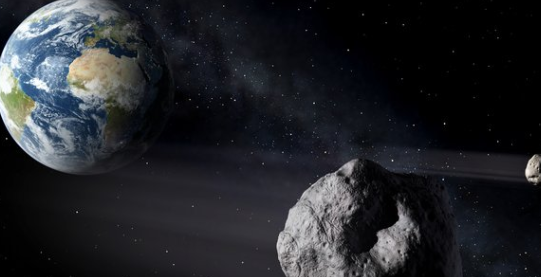You ever hear about Asteroid Day? Most not into the field haven’t a clue.
This week, two large asteroids will make a safe passage close to Earth, coinciding with this year’s celebration of Asteroid Day. The first asteroid, known as 2024 MK, was only discovered on June 16, 2024, and will approach Earth on June 29. Measuring between 120 and 260 meters in diameter, it will pass at about 290,000 kilometers from Earth, roughly 75% of the distance to the Moon. Although it poses no threat of impact, its recent discovery underscores the ongoing need to enhance our detection of potentially hazardous near-Earth objects (NEOs).
2024 MK will be visible with a small telescope or good binoculars in clear dark skies, making it an exciting observation opportunity for amateur astronomers, especially during the height of Asteroid Day activities.
Two large asteroids, 2024 MK and 2011 UL21, will make a close flyby near Earth this week, coinciding with Asteroid Day. 2024 MK, recently discovered, poses no threat despite its size. 2011 UL21, significantly larger, will pass at a safe distance.https://t.co/P0H2c1GHOk
— Tech Times (@TechTimes_News) June 24, 2024
The second asteroid, designated (415029) 2011 UL21, is significantly larger, measuring 2,310 meters across, making it larger than 99% of known NEOs. However, it will remain much farther from Earth, passing at over 17 times the distance to the Moon on June 27. This asteroid’s orbit is notably steeply inclined compared to most large objects in the solar system, which typically orbit closer to the equatorial plane. This unusual orbit may result from gravitational interactions with large planets like Jupiter, which can deflect asteroids towards Earth.
The interaction between Jupiter and such asteroids is critical to understand as it affects their trajectory and potential threat level. (415029) 2011 UL21 is in an ’11:34 resonance’ with Earth, completing 11 orbits around the Sun for every 34 Earth orbits. This orbital pattern allows for the creation of visual patterns of the asteroid’s position relative to Earth over decades.
Two large asteroids safely pass Earth just 42 hours apart#Space #AsteroidDay #NearEarth pic.twitter.com/SluZoW6GEh
— Space News (@Automation404) June 24, 2024
Asteroid Day, endorsed by the United Nations, commemorates the largest observed asteroid impact in recorded history—the 1908 Tunguska event in Siberia, which flattened around 80 million trees and narrowly missed affecting more populated areas of Europe. The day highlights the importance of asteroid impact awareness and the influence of these celestial bodies on Earth’s history.
The European Space Agency (ESA) plays a crucial role in monitoring asteroid threats through its Planetary Defence Office. Over the past two decades, ESA has focused on detecting and analyzing potentially hazardous NEOs, estimated to number around 5 million that are larger than 20 meters. Upcoming missions like ESA’s Hera, part of the first global asteroid deflection test, will survey the asteroid Dimorphos following NASA’s DART mission impact in 2022, aiming to establish a repeatable planetary defense strategy.
Two large asteroids safely pass Earth just 42 hours apart: https://t.co/2J9Bzc5LXg
— Ken Gusler (@kgusler) June 24, 2024
Additionally, ESA is developing technologies such as the Flyeye telescope network, which scans the sky nightly with a wide field of view to detect incoming asteroids. The future NEOMIR satellite will use infrared technology to identify asteroids approaching from the sunward side, which are typically hard to detect from Earth due to solar glare.
Key Points:
i. Two large asteroids will safely pass close to Earth this week, coinciding with Asteroid Day celebrations.
ii. Asteroid 2024 MK, discovered just two weeks ago, will pass within 290,000 kilometers of Earth and be visible with small telescopes.
iii. The larger asteroid, (415029) 2011 UL21, will pass at a much greater distance but has an unusual steeply inclined orbit influenced by Jupiter.
iv. Asteroid Day commemorates the 1908 Tunguska event and highlights the importance of asteroid impact awareness and preparedness.
v. ESA is enhancing planetary defense with projects like the Hera mission and developing technologies like Flyeye telescopes and the NEOMIR satellite for better asteroid detection.
Fallon Jacobson – Reprinted with permission of Whatfinger News



